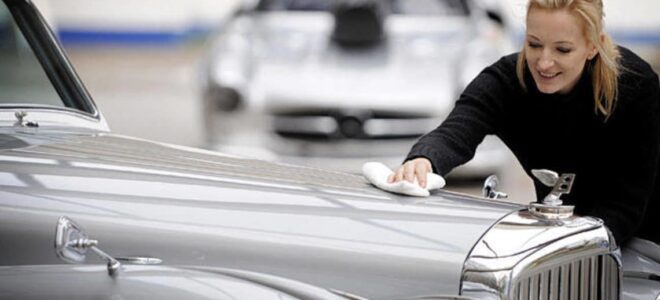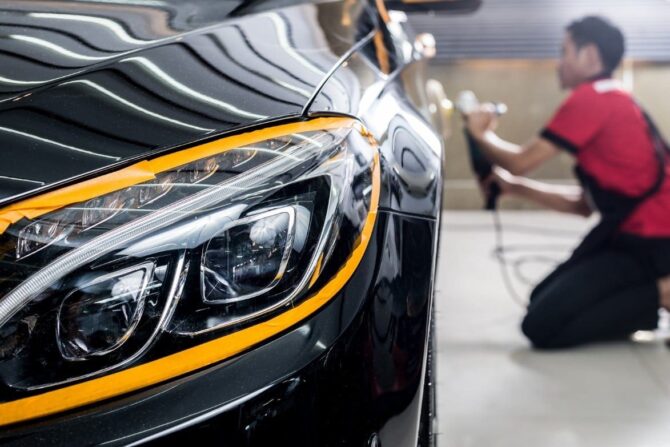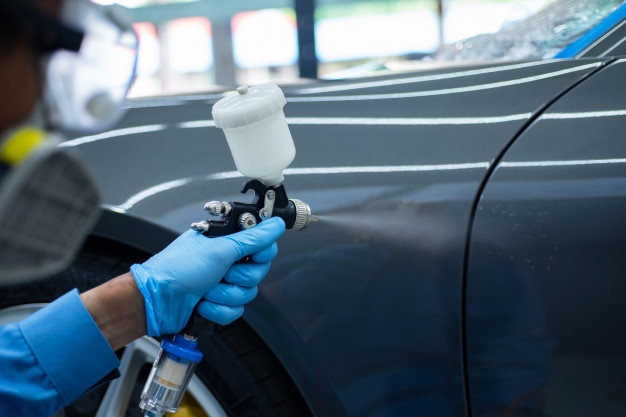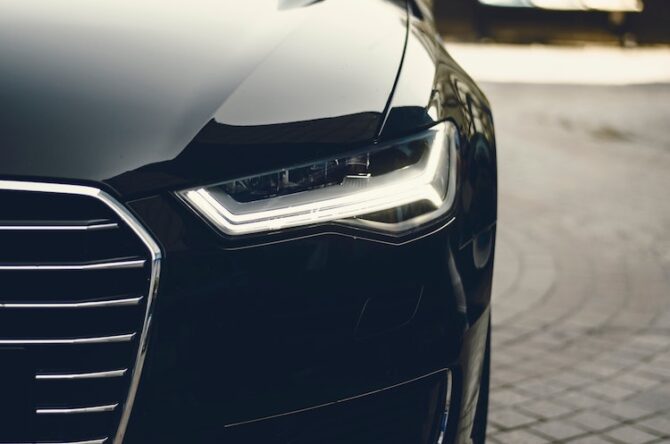
Dealers frequently provide paint protection treatment as an optional extra to customers purchasing a new vehicle.
It’s essentially an invisible protective layer placed over the top of the car’s paintwork. Stone chips, tree sap, fading, and bird droppings, all of which are frequent and harmful to untreated automobiles, are all protected by it.
However, it does not cover more serious damage such as parking scuffs and dents. Paint protection comes in a variety of forms, including a physical film or a liquid that is sprayed on and sets.
You’ve picked your new car, go for a test drive in it, and are now sitting in your office considering vehicle choices, including new car paint protection. This is an optional treatment that is only available if you are purchasing a new vehicle. Your automobile will not undergo any major changes.
Dealers are frequently eager to offer such treatments to customers who want to maintain their new vehicle looking as nice as possible. The cost of a simple coating on a small automobile might range from a few hundred pounds to four figures for more complicated protection on large or premium cars.
aDealers earn a lot of money from optional extras in any case, and it’s reasonable to infer that they’re making a profit.
Is It Worth the Money You Spend on It?

Source: cleangetaway.com.au
Paint protection is a great, low-maintenance approach to keep your car’s exterior looking great. It will be easy to clean, and you will not have to worry as much about polishing or minor damage.
Consider where your automobile will spend most of its time while you are not driving it before deciding whether or not to pay for it. Car paint protection is definitely a smart purchase if you park it outside the whole night near trees or overhead lines where birds perch. You can check out ceramicprosydney.com.au for a few worthwhile solutions to paint protection for your car.
If you drive a lot, it’s particularly worth thinking about since the paintwork is more prone to pick up little particles of damage like stone chips.
If the automobile is regularly garaged overnight, seldom spends an evening outside, or doesn’t travel a great distance, a protective coating is generally unnecessary.
There’s also no justification for protective products if you’re willing to clean your car frequently and look after the paintwork or hire a professional detailer to shine it and remove any imperfections. Depending on how often you clean your car, this method may also be less expensive.
In the end, it’s up to you to decide, and you should base your decision on how you use your automobile and your needs, not on the salesman’s slick talk. It’s also an excellent place to haggle, so try to acquire it for less than the dealer’s original offer.
If you opt to purchase paint protection with your new automobile, make sure it’s included somewhere in the sales papers, since it may offer the car a minor advantage when it comes time to sell it.
Protecting Your Paint Scheme
There are numerous forms of paint protection on the market. Because these powerful chemicals are not designed for human skin, the most frequent method is to spray them on.
Polymer paint sealants are among the compounds in your paint protection. For a limited time, these compounds are intended to provide a layer of protection.
It’s recommended to have them done many times a year if you want to maintain your paintwork all year. If your car gets very dirty, you should reapply it after cleaning and polishing it.
How Is This Paint Applied?

Source: cleangetaway.com.au
Ceramic paint protection, often known as nano-coatings, necessitates more prep work than standard waxes or sealants. The vehicle is coated with a thin coating that establishes a chemical connection that can only be broken by abrasion.
On the other hand, Paint sealants have done an excellent job of safeguarding our automobiles for decades. Just because a cool, new option has appeared on the scene, it doesn’t imply they’ve ceased operating the same way they’ve always done.
Your paint will still be smooth and glossy. They still make cleaning your automobile simpler. They still bead water as they’ve always done.
The easiest approach to apply a paint sealant to your automobile is to first carefully prepare the surface. Washing it, machine polishing it, decontaminating it with a clay bar, and wiping it down with isopropyl alcohol to make sure it’s clean and it’s ready for the sealant is all part of the process.
Now that you know what is used to preserve the paint on your automobile, how and when is it applied? The quick answer is that it is applied to the color directly. Under the protection, there is no wax, polish, or other material.
It is applied on raw paint in order for it to bind to the paint and provide extended protection. After the paint protection is applied, the car is waxed and shined before being delivered to you.
When comparing a sealant to a coating, one of the major drawbacks is how long they stay. Without getting into too much detail, the basic rule is that waxes endure for weeks, sealants for months, and coatings for years. However, that added security comes at a price, and it’s generally a significant one.
The product itself contributes to the high cost of a ceramic coating, but the majority of it is due to the work required to apply it.
The Prep Work for Car Paint Protection
That means that when it comes to utilizing your protective product of choice, preparation is crucial. A frequent misconception regarding ceramic coatings is that they make your paint look darker and shinier, but they don’t.
What makes your paint shine is the prep work you did prior. When applying a permanent (or semi-permanent) coating, this is a crucial step because you don’t want to get stuck in any paint that isn’t flawless. It’s one of the reasons why applying a wax or sealant is so much easier because there’s no prep work involved.
A quick question for you: What happens if we prep it the same way we would if we were putting on a coating, even though we’re simply going to apply a paint sealant? The quick answer is that our sealant will provide us with the best results possible.
The long answer is that we’ve double-checked that the surface is absolutely clean and devoid of any contaminants. By polishing the paint with oils and abrasives, we were able to bring out its inherent shine and depth.
The surface has been smoothed, giving the sealer the best opportunity of adhering to the paint. They will wash and maintain it as if they spent over $1,000 on a ceramic coating after it’s all done.
If you’re not familiar with the ceramic coating process, this may sound daunting. Don’t worry, I’ll go through everything in detail below. The key is that treating this like a ceramic coating treatment will extend the life of your paint sealant.
The best part is that these additional processes are entirely optional. You don’t have access to a machine polisher? Skip that step if you want. You don’t want to use a clay bar because you’re too lazy? Don’t worry about it; just go on to the next step. Just keep in mind that each of these processes will have an impact on how your paint sealant acts and how long it lasts.
The Final Process of Car Paint Protection

Source: sg-accounting.co.uk
If you are doing it on your own, you need to keep these few points in mind.
If you’re on the fence regarding paint protection, experts advise that you might question if you can save money by doing it yourself. It is not safe, to put it bluntly. These are highly powerful compounds that should only be used by specialists. There are a number of reasons why you should refrain from using the drugs yourself.
You are putting your health in danger if you apply them without the necessary safety equipment.
The automobile must be stripped of all other goods in order for the protection to operate. It will not adhere well if anything is left behind.
To guarantee adherence, the paint must be cleaned by a professional.
If you apply it yourself, there is no way to fix any scratches or marks that are left behind.
Washing and Blow-Drying Your Car
Of course, the first thing you’ll want to do is properly clean your vehicle. If you like, you may use a pressure washer and a foam cannon, but they aren’t essential.
This is one situation when we want to remove any remaining wax or sealer from the paint. You may also perform the task with an all-purpose cleaner in addition to your normal soap.
Blowing your automobile dry is a personal preference. You are welcome to roll the dice by simply drying them with a cloth. If you decide to go that way, be cautious about where you apply the sealant.
The Bottom Line
Paint protection for new cars is an optional service. You have no mechanical need to install it in your car. It is, nevertheless, an excellent idea if you are worried about maintaining the shine or preserving the value. Maintaining the appearance of your automobile is a substantial and long-term investment. Always keep in mind that paint protection only goes so far.



